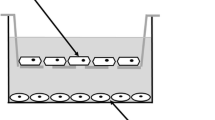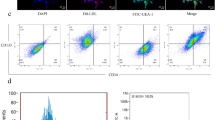Abstract
Restenosis after angioplasty is a serious clinical problem that can result in re-occlusion of the coronary artery. Although current drug-eluting stents have proved to be more effective in reducing restenosis, they have drawbacks of inhibiting reendothelialization to promote thrombosis. New treatment options are in urgent need. We have shown that netrin-1, an axon-guiding protein, promotes angiogenesis and cardioprotection via production of nitric oxide (NO). The present study examined whether and how netrin-1 attenuates neointimal formation in a femoral wire injury model. Infusion of netrin-1 into C57BL/6 mice markedly attenuated neointimal formation following wire injury of femoral arteries, measured by intimal to media ratio (from 1.94 ± 0.55 to 0.45 ± 0.86 at 4 weeks). Proliferation of VSMC in situ was largely reduced. This protective effect was absent in DCC+/− animals. NO production was increased by netrin-1 in both intact and injured femoral arteries, indicating netrin-1 stimulation of endogenous NO production from intact endothelium and remaining endothelial cells post-injury. VSMC migration was abrogated by netrin-1 via a NO/cGMP/p38 MAPK pathway, while timely EPC homing was induced. Injection of netrin-1 preconditioned wild-type EPCs, but not EPCs of DCC+/− animals, substantially attenuated neointimal formation. EPC proliferation, NO production, and resistance to oxidative stress induced apoptosis were augmented by netrin-1 treatment. In conclusion, our data for the first time demonstrate that netrin-1 is highly effective in reducing neointimal formation following vascular endothelial injury, which is dependent on DCC, and attributed to inhibition of VSMC proliferation and migration, as well as improved EPC function. These data may support usage of netrin-1 and netrin-1 preconditioned EPCs as novel therapies for post angioplasty restenosis.
Key message
-
Netrin-1 attenuates neointimal formation following post endothelial injury via DCC and NO.
-
Netrin-1 inhibits VSMC proliferation in situ following endothelial injury.
-
Netrin-1 inhibits VSMC migration via a NO/cGMP/p38 MAPK pathway.
-
Netrin-1 augments proliferation of endothelial progenitor cells (EPCs) and EPC eNOS/NO activation.
-
Netrin-1 enhances resistance of EPCs to oxidative stress, improving re-endothelialization following injury.









Similar content being viewed by others
References
Garg S, Serruys PW (2010) Coronary stents: current status. J Am Coll Cardiol 56:S1–42
Chaabane C, Otsuka F, Virmani R, Bochaton-Piallat ML (2013) Biological responses in stented arteries. Cardiovasc Res 99:353–363
Thadani U, Rodgers T (2006) Side effects of using nitrates to treat angina. Expert Opin Drug Saf 5:667–674
Munzel T, Daiber A, Mulsch A (2005) Explaining the phenomenon of nitrate tolerance. Circ Res 97:618–628
Kennedy TE, Serafini T, de la Torre JR, Tessier-Lavigne M (1994) Netrins are diffusible chemotropic factors for commissural axons in the embryonic spinal cord. Cell 78:425–435
Serafini T, Kennedy TE, Galko MJ, Mirzayan C, Jessell TM, Tessier-Lavigne M (1994) The netrins define a family of axon outgrowth-promoting proteins homologous to C. elegans UNC-6. Cell 78:409–424
Bouhidel JO, Wang P, Li Q, Cai H (2014) Pharmacological postconditioning treatment of myocardial infarction with netrin-1. Front Biosci (Landmark Ed) 19:566–570
Nguyen A, Cai H (2006) Netrin-1 induces angiogenesis via a DCC-dependent ERK1/2-eNOS feed-forward mechanism. Proc Natl Acad Sci U S A 103:6530–6535
Zhang J, Cai H (2010) Netrin-1 prevents ischemia/reperfusion-induced myocardial infarction via a DCC/ERK1/2/eNOS s1177/NO/DCC feed-forward mechanism. J Mol Cell Cardiol 48:1060–1070
Bouhidel JO, Wang P, Siu KL, Li H, Youn JY, Cai H (2014) Netrin-1 improves post-injury cardiac function in vivo via DCC/NO-dependent preservation of mitochondrial integrity, while attenuating autophagy. Biochim Biophys Acta 1852:277–289
Siu KL, Lotz C, Ping P, Cai H (2014) Netrin-1 abrogates ischemia/reperfusion-induced cardiac mitochondrial dysfunction via nitric oxide-dependent attenuation of NOX4 activation and recoupling of NOS. J Mol Cell Cardiol 78:174–185
Li Q, Cai H (2015) Induction of cardioprotection by small netrin-1 derived peptides. Am J Physiol Cell Physiol DOI: ajpcell 00332:02014
Li Q, Wang P, Ye K, Cai H (2015) Central role of SIAH inhibition in DCC-dependent cardioprotection provoked by netrin-1/NO. Proc Natl Acad Sci U S A 112:899–904
Sata M, Maejima Y, Adachi F, Fukino K, Saiura A, Sugiura S, Aoyagi T, Imai Y, Kurihara H, Kimura K et al (2000) A mouse model of vascular injury that induces rapid onset of medial cell apoptosis followed by reproducible neointimal hyperplasia. J Mol Cell Cardiol 32:2097–2104
Oak JH, Cai H (2007) Attenuation of angiotensin II signaling recouples eNOS and inhibits nonendothelial NOX activity in diabetic mice. Diabetes 56:118–126
Ahanchi SS, Tsihlis ND, Kibbe MR (2007) The role of nitric oxide in the pathophysiology of intimal hyperplasia. J Vasc Surg 45(Suppl A):A64–A73
Bahnson ES, Koo N, Cantu-Medellin N, Tsui AY, Havelka GE, Vercammen JM, Jiang Q, Kelley EE, Kibbe MR (2014) Nitric oxide inhibits neointimal hyperplasia following vascular injury via differential, cell-specific modulation of SOD-1 in the arterial wall. Nitric Oxide 44C:8–17
Kong D, Melo LG, Mangi AA, Zhang L, Lopez-Ilasaca M, Perrella MA, Liew CC, Pratt RE, Dzau VJ (2004) Enhanced inhibition of neointimal hyperplasia by genetically engineered endothelial progenitor cells. Circulation 109:1769–1775
Ingram DA, Krier TR, Mead LE, McGuire C, Prater DN, Bhavsar J, Saadatzadeh MR, Bijangi-Vishehsaraei K, Li F, Yoder MC et al (2007) Clonogenic endothelial progenitor cells are sensitive to oxidative stress. Stem Cells 25:297–304
Vasa M, Fichtlscherer S, Adler K, Aicher A, Martin H, Zeiher AM, Dimmeler S (2001) Increase in circulating endothelial progenitor cells by statin therapy in patients with stable coronary artery disease. Circulation 103:2885–2890
Vasa M, Fichtlscherer S, Aicher A, Adler K, Urbich C, Martin H, Zeiher AM, Dimmeler S (2001) Number and migratory activity of circulating endothelial progenitor cells inversely correlate with risk factors for coronary artery disease. Circ Res 89:E1–E7
Gao L, Li P, Zhang J, Hagiwara M, Shen B, Bledsoe G, Chang E, Chao L, Chao J (2014) Novel role of kallistatin in vascular repair by promoting mobility, viability, and function of endothelial progenitor cells. J Am Heart Assoc 3:e001194
Wilson BD, Ii M, Park KW, Suli A, Sorensen LK, Larrieu-Lahargue F, Urness LD, Suh W, Asai J, Kock GA et al (2006) Netrins promote developmental and therapeutic angiogenesis. Science 313:640–644
Yang Y, Zou L, Wang Y, Xu KS, Zhang JX, Zhang JH (2007) Axon guidance cue netrin-1 has dual function in angiogenesis. Cancer Biol Ther 6:743–748
von der Leyen HE, Gibbons GH, Morishita R, Lewis NP, Zhang L, Nakajima M, Kaneda Y, Cooke JP, Dzau VJ (1995) Gene therapy inhibiting neointimal vascular lesion: in vivo transfer of endothelial cell nitric oxide synthase gene. Proc Natl Acad Sci U S A 92:1137–1141
Marks DS, Vita JA, Folts JD, Keaney JF Jr, Welch GN, Loscalzo J (1995) Inhibition of neointimal proliferation in rabbits after vascular injury by a single treatment with a protein adduct of nitric oxide. J Clin Invest 96:2630–2638
Oemar BS, Tschudi MR, Godoy N, Brovkovich V, Malinski T, Luscher TF (1998) Reduced endothelial nitric oxide synthase expression and production in human atherosclerosis. Circulation 97:2494–2498
Ross R (1993) The pathogenesis of atherosclerosis: a perspective for the 1990s. Nature 362:801–809
Alef MJ, Vallabhaneni R, Carchman E, Morris SM Jr, Shiva S, Wang Y, Kelley EE, Tarpey MM, Gladwin MT, Tzeng E et al (2011) Nitrite-generated NO circumvents dysregulated arginine/NOS signaling to protect against intimal hyperplasia in Sprague-Dawley rats. J Clin Invest 121:1646–1656
Surks HK (2007) cGMP-dependent protein kinase I and smooth muscle relaxation: a tale of two isoforms. Circ Res 101:1078–1080
Wang XQ, Lindberg FP, Frazier WA (1999) Integrin-associated protein stimulates alpha2beta1-dependent chemotaxis via Gi-mediated inhibition of adenylate cyclase and extracellular-regulated kinases. J Cell Biol 147:389–400
Iijima K, Yoshizumi M, Hashimoto M, Akishita M, Kozaki K, Ako J, Watanabe T, Ohike Y, Son B, Yu J et al (2002) Red wine polyphenols inhibit vascular smooth muscle cell migration through two distinct signaling pathways. Circulation 105:2404–2410
Wang Z, Castresana MR, Newman WH (2004) Reactive oxygen species-sensitive p38 MAPK controls thrombin-induced migration of vascular smooth muscle cells. J Mol Cell Cardiol 36:49–56
Engel FB, Schebesta M, Duong MT, Lu G, Ren S, Madwed JB, Jiang H, Wang Y, Keating MT (2005) p38 MAP kinase inhibition enables proliferation of adult mammalian cardiomyocytes. Genes Dev 19:1175–1187
Kim SO, Xu Y, Katz S, Pelech S (2000) Cyclic GMP-dependent and -independent regulation of MAP kinases by sodium nitroprusside in isolated cardiomyocytes. Biochim Biophys Acta 1496:277–284
Li Z, Zhang G, Feil R, Han J, Du X (2006) Sequential activation of p38 and ERK pathways by cGMP-dependent protein kinase leading to activation of the platelet integrin alphaIIb beta3. Blood 107:965–972
Lopez-Bergami P (2011) The role of mitogen- and stress-activated protein kinase pathways in melanoma. Pigment Cell Melanoma Res 24:902–921
Fujiyama S, Amano K, Uehira K, Yoshida M, Nishiwaki Y, Nozawa Y, Jin D, Takai S, Miyazaki M, Egashira K et al (2003) Bone marrow monocyte lineage cells adhere on injured endothelium in a monocyte chemoattractant protein-1-dependent manner and accelerate reendothelialization as endothelial progenitor cells. Circ Res 93:980–989
Yamamoto T, Shibata R, Ishii M, Kanemura N, Kito T, Suzuki H, Miyake H, Maeda K, Tanigawa T, Ouchi N et al (2013) Therapeutic reendothelialization by induced pluripotent stem cells after vascular injury—brief report. Arterioscler Thromb Vasc Biol 33:2218–2221
Griese DP, Ehsan A, Melo LG, Kong D, Zhang L, Mann MJ, Pratt RE, Mulligan RC, Dzau VJ (2003) Isolation and transplantation of autologous circulating endothelial cells into denuded vessels and prosthetic grafts: implications for cell-based vascular therapy. Circulation 108:2710–2715
Imanishi T, Moriwaki C, Hano T, Nishio I (2005) Endothelial progenitor cell senescence is accelerated in both experimental hypertensive rats and patients with essential hypertension. J Hypertens 23:1831–1837
Juni RP, Duckers HJ, Vanhoutte PM, Virmani R, Moens AL (2013) Oxidative stress and pathological changes after coronary artery interventions. J Am Coll Cardiol 61:1471–1481
Acknowledgements
This work was supported by the National Institute of Health National Heart, Lung and Blood Institute (NHLBI) Grants HL077440 (HC), HL088975 (HC), HL108701 (HC, DGH), HL119968 (HC), an American Heart Association Established Investigator Award (EIA) 12EIA8990025 (HC) and an American Heart Association Predoctoal Fellowship Award 14PRE20380184 (NML).
Author information
Authors and Affiliations
Corresponding author
Ethics declarations
Conflict of interest
The authors declare that they have no conflict of interests.
Additional information
Norika Mengchia Liu and Kin Lung Siu contribute equally to this study.
Rights and permissions
About this article
Cite this article
Liu, N.M., Siu, K.L., Youn, J.Y. et al. Attenuation of neointimal formation with netrin-1 and netrin-1 preconditioned endothelial progenitor cells. J Mol Med 95, 335–348 (2017). https://doi.org/10.1007/s00109-016-1490-4
Received:
Revised:
Accepted:
Published:
Issue Date:
DOI: https://doi.org/10.1007/s00109-016-1490-4
Keywords
- Netrin-1
- Neointimal formation
- Vascular smooth muscle cell (VSMC) proliferation
- VSMC migration
- Femoral wire injury
- Deleted in colorectal cancer (DCC)
- Endothelial progenitor cells (EPCs)
- EPC proliferation
- Endothelial nitric oxide synthase (eNOS) phosphorylation
- NO production
- EPC resistance to oxidative stress
- EPC homing
- Re-endothelialization




